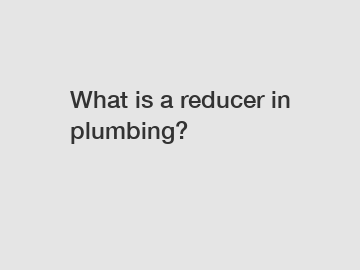What is a reducer in plumbing?
What is a Reducer in Plumbing?
Plumbing is an intricate system that ensures the proper functioning of our homes and buildings. From the main water supply to the faucets and showers, every component plays a vital role. One such component that often goes unnoticed but is crucial to maintaining the integrity of the plumbing system is a reducer. In this blog post, we will explore what a reducer is in plumbing and its significance in ensuring efficient water flow.
A reducer, in plumbing terms, is a fitting that allows for a smooth transition between two pipes of different diameter. It is designed to reduce the pipe size, hence its name. These fittings come in various shapes and sizes, such as concentric reducers, eccentric reducers, and reducing couplings. Each serves a specific purpose based on the plumbing requirement.

So why do we need reducers in our plumbing system? Well, imagine connecting a pipe with a large diameter directly to one with a small diameter. The sudden change in size would result in turbulent water flow, leading to increased pressure, noise, and even potential damage to the pipes. Furthermore, it would obstruct the efficient movement of water, causing various inconveniences in our daily activities, such as reduced water pressure in showers or faucets.
Reducers, on the other hand, address this issue by providing a gradual transition between pipes of different sizes. By connecting the large diameter pipe to the reducer and gradually decreasing the size until it matches the smaller diameter pipe, reducers ensure a smooth and continuous water flow without any disruptions or limitations. Additionally, they help maintain a constant pressure in the system, avoiding unnecessary strain on pipes and fixtures.
The choice of reducer type depends on the specific plumbing needs. Concentric reducers are commonly used when maintaining the centerline of the pipes is critical. These fittings have a symmetrical design, ensuring the same centerline for both the inlet and outlet pipes. On the other hand, eccentric reducers are used to connect pipes that are not aligned at the same level. They have an off-center design, allowing for a gradual transition without causing any misalignment in the system.
Apart from their functional benefits, reducers also offer added advantages in terms of water conservation. By minimizing pressure fluctuations and optimizing water flow, these fittings contribute to conserving water and energy. They also reduce the likelihood of leaks, resulting in less water wastage and potential damage to your property.
Reducers are made from various materials, including copper, brass, PVC, and stainless steel. When selecting the right material, it is essential to consider factors such as compatibility with the existing plumbing system, durability, and resistance to corrosion or chemical reactions. Consulting a professional plumber or plumbing supplier can help you make an informed choice based on your specific requirements.
In conclusion, reducers play a vital role in maintaining the efficiency and reliability of plumbing systems. They allow for a smooth transition between pipes of different sizes, minimizing pressure fluctuations and maximizing water flow. Whether it's a residential or commercial plumbing setup, incorporating reducers ensures a hassle-free experience with consistent water pressure and flow. So, next time you marvel at the convenience of your plumbing system, spare a thought for the humble reducer quietly working behind the scenes to keep things running smoothly.
For more lap joint flange welding, eccentric flanged reducer, carbon steel seamless pipesinformation, please contact us. We will provide professional answers.


